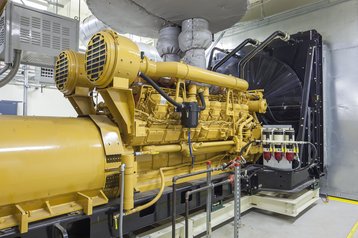The uninterruptible power system (UPS) and standby generator both play an important role in ensuring 24/7 uptime in the data center environment.
While UPSs serve as the first line of defense against dirty power, data loss and equipment damage—providing critical backup power during short-term blackouts–generators offer the next layer of support for applications where extended runtime is needed.
Considering the complementary functions that UPSs and standby generators have in protecting data centers from downtime, it’s important to address the hurdles that exist when it comes to synchronization. Data center managers should understand the operational characteristics, interactions and design of the devices to ensure a strong alignment.
In the spirit of forging a harmonious relationship, below are six steps data center operators can take to drive UPS-generator system reliability and performance.
Considering the complementary functions that UPSs and standby generators have in protecting data centers from downtime, it’s important to address the hurdles that exist when it comes to synchronization. Data center managers should understand the operational characteristics, interactions and design of the devices to ensure a strong alignment.
In the spirit of forging a harmonious relationship, below are six steps data center operators can take to drive UPS-generator system reliability and performance:
1 - Assess the generator voltage and frequency regulation. Every UPS has a set input voltage and frequency window that, if exceeded, will cause the UPS to reject the generator as a source, and go on battery. If a generator’s frequency or voltage range is too wide for the UPS to accept, then the UPS may interpret the generator as an unstable power source. If this occurs, the UPS remains on battery permanently, which will ultimately cause the battery to completely discharge and drop the critical load.
2 - Size up the generator. The bigger the generator engine, the more stable the frequency, and therefore the more inrush it can handle as the UPS comes off battery and begins to draw power from the generator. With that in mind, whenever budgets permit, it’s wise to size up and also allow for some potential growth with a generator friendly UPS. Note that different generators, UPSs and regulator types preclude any vendor’s ability to “guarantee” a successful UPS-generator interface. So, the general recommendations for UPS models up to 25 kilowatts (kW) are as follows:
- 3 times the total load (including the UPS input power, A/C, and all other equipment that must remain online) for gasoline, propane, natural gas-powered and mechanical governor generators.
- 1.25 to 1.5 times the total load for diesel-powered generators and those with an electronic governor.
3 - Consider the fuel source. The most common generator fuel options include propane, natural gas and diesel, each of which comes with its own set of advantages and disadvantages. Propane and natural gas-operating generators can be slower to respond and may need to be sized larger than their diesel counterparts. Diesel is widely considered the best fuel and is predominant for generator solutions 50 kW and larger; however, it has a short storage life and its cost can strain budgets.
4 - Don’t overlook the governor. Most generators are equipped with a governor, which limits the speed of fuel being delivered to the engine to a safe level amid load changes, and stabilizes the voltage and frequency of the generator output. Electronic governors are quick to respond, while mechanical governors are slower and can also cause calibration challenges.
5 - Consider the UPS topology. The type of UPS will also impact UPS generator compatibility and configuration, as not all can compensate for frequency variations without relying on the battery. Both standby and line-interactive UPSs use battery power to prevent frequency variations from affecting the protected load. So, a generator’s unstable frequency may cause the type of UPS to transition to and from battery frequently while the generator is running. A double-conversion, online UPS, on the other hand, has a wider acceptable window for input voltage and frequency. It recreates the sine wave and filters frequency variations as part of its normal operation, thereby preserving battery life.
6 - Consult with the manufacturers. Often you can avoid a range of potential problems and the UPS not working on generator power by first ensuring that the generator manufacturer has tested and approved the product’s intended use with UPSs. To ensure that optimal UPS vs. generator sizing is achieved, consult with both the UPS and the generator manufacturer prior to finalizing a purchase. In addition, capacities of prospective loads to be protected can generally be found in the manufacturer’s specifications.
Data center operators face considerable pressure to save time, save money and increase operational efficiencies, all while keeping systems up and running. By forming a strategic alignment between standby generators and UPSs, organizations can tackle these objectives and stay protected. And, like a solid marriage grounded in teamwork and trust, organizations will have a platform that is built to stand the test of time.


